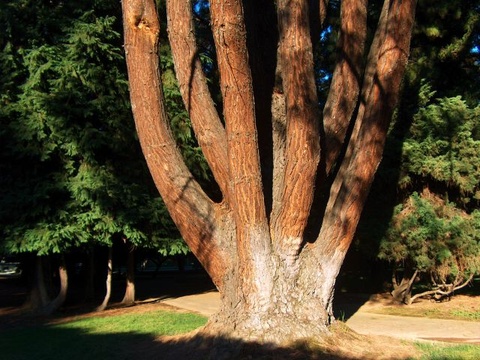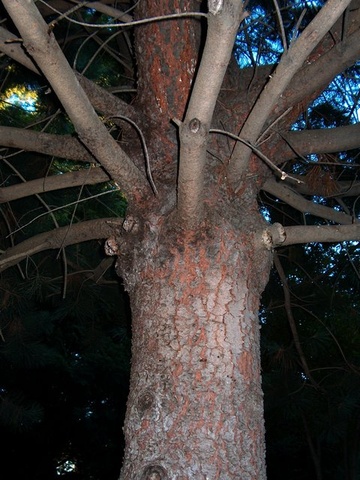Conifers native to the Yuba-Sutter area are members of the cypress, pine, and yew families. Most are trees, but several are small enough to be considered shrubs. All the conifers native to the Yuba-Sutter area are evergreen.
In Marysville, it is illegal to plant any tree in the pine or yew families directly adjacent to a public street or where it may overhang a public street.
Cypress Family
California Juniper
California juniper is a 9- to 25-foot-tall by 5- to 10-foot-wide shrub or small tree that is native to Sutter County and typically grows at elevations below 5,000 feet. It is most often found on dry, rocky slopes in central oak woodland. It prefers full sun. It attracts bushtits.
You can read more about it at the Theodore Payne Wiki and the Las Pilitas Nursery website. You can see pictures of it at CalPhotos, Flickr, and Picasa. You can find out where to buy it at the California Native Plant Link Exchange.
MacNab's Cypress
MacNab's cypress is a 10- to 36-foot-tall by 5- to 10-foot-wide shrub or small tree that is native to Yuba County and typically grows at elevations between 1,000 and 2,500 feet. It is most often found on dry slopes in central oak woodland. It tolerates serpentine.
You can read more about it at the Theodore Payne Wiki and the Las Pilitas Nursery website. You can see pictures of it at CalPhotos, Flickr, and Picasa. You can find out where to buy it at the California Native Plant Link Exchange.
Incense Cedar
Incense cedar (also called bastard cedar) is a 70- to 150-foot-tall by 10- to 15-foot-wide tree that is native to Yuba County and typically grows at elevations between 2,500 and 8,000 feet. It is most often found on slopes and in canyons in yellow pine forest. It tolerates partial shade and serpentine.
You can read more about it at the Theodore Payne Wiki, the Las Pilitas Nursery website, and USDA Conservation Plant Characteristics. You can see pictures of it at CalPhotos, Flickr, and Picasa. You can find out where to buy it at the California Native Plant Link Exchange.
Pine Family
Gray Pine
 Gray pines (Pinus sabiniana) in Hammon Grove Park display characteristically rounded tops, with mostly bare trunks below. Photo by queerbychoice. Gray Pine (also called foothill pine) is a 30- to 70-foot-tall by 10- to 30-foot-wide tree that is native to Yuba County and typically grows at elevations below 4,500 feet. It is most often found on rocky slopes in central oak woodland. It prefers full sun and tolerates serpentine. It attracts Nuttall's woodpeckers.
Gray pines (Pinus sabiniana) in Hammon Grove Park display characteristically rounded tops, with mostly bare trunks below. Photo by queerbychoice. Gray Pine (also called foothill pine) is a 30- to 70-foot-tall by 10- to 30-foot-wide tree that is native to Yuba County and typically grows at elevations below 4,500 feet. It is most often found on rocky slopes in central oak woodland. It prefers full sun and tolerates serpentine. It attracts Nuttall's woodpeckers.
You can read more about it at the Theodore Payne Wiki, the Las Pilitas Nursery website, and USDA Conservation Plant Characteristics. You can see pictures of it at CalPhotos, Flickr, and Picasa. You can find out where to buy it at the California Native Plant Link Exchange.
 Gray pine (Pinus sabiniana) in the California State University Sacramento arboretum. Photo by queerbychoice.
Gray pine (Pinus sabiniana) in the California State University Sacramento arboretum. Photo by queerbychoice.
Donna M. Landerman's column "A Drug Store in the Maidu's Back Yard," printed in the Territorial Dispatch on November 11, 2009, explains some of the many uses of gray pines:
| Foothill pine, To'-nim chahm. Along with the oaks, this graceful pine defines our landscape. It is more round-topped and open-branched than most pines; you can see right through them. The foliage has a grayish cast, the needles long (as long as 15 inches), in bunches of three. |
| While a beautiful tree, it is not highly valued by people today. But Nisenan, as well as early [white] settlers, found it a very useful tree. The nuts of its gigantic cones—some almost one foot long and six inches in diameter, weighing as much as four pounds—were laboriously collected. This was a sticky job. The pitchy, green cones were knocked from the tree and held over a fire until their scales opened, releasing the hard coated seeds. These were then cracked open to remove the tasty kernels within. But it was worth it, for the seeds are over 51% at and 28% protein—power-packed food. High fat foods were rare in the Nisenan diet, and therefore prized. |
| The pitch itself was a useful glue and could be used to make torches for night travel. White settlers are also known to have used it as a kind of band aid coating over sores and burns. Some even chewed the pitch when it thickened into a gum as a cure for rheumatism or as a kind of chewing gum. (I tried it myself when I was a young girl living in the foothills below Redding and wandering around the hill. It tasted pretty good.) |
Balsam Fir
Balsam fir (also called white fir or silver fir) is a 60- to 180-foot-tall by 20-foot-wide tree that is native to Yuba County and typically grows at elevations below 10,000 feet. It is found in yellow pine forest. It tolerates full shade.
You can read more about it at the Theodore Payne Wiki, the Las Pilitas Nursery website, and USDA Conservation Plant Characteristics. You can see pictures of it at CalPhotos, Flickr, and Picasa. You can find out where to buy it at the California Native Plant Link Exchange.
Sugar Pine
 Sugar pine (Pinus lambertiana) in the California State University Sacramento arboretum. Photo by queerbychoice. Sugar Pine is a 175- to 230-foot-tall by 10- to 25-foot-wide tree that is native to Yuba County and typically grows at elevations below 9,000 feet. It is most often found on rocky slopes in yellow pine forest. It tolerates partial shade.
Sugar pine (Pinus lambertiana) in the California State University Sacramento arboretum. Photo by queerbychoice. Sugar Pine is a 175- to 230-foot-tall by 10- to 25-foot-wide tree that is native to Yuba County and typically grows at elevations below 9,000 feet. It is most often found on rocky slopes in yellow pine forest. It tolerates partial shade.
You can read more about it at the Theodore Payne Wiki, the Las Pilitas Nursery website, and USDA Conservation Plant Characteristics. You can see pictures of it at CalPhotos, Flickr, and Picasa. You can find out where to buy it at the California Native Plant Link Exchange.
Douglas-Fir
Douglas-fir is a 175- to 200-foot-tall by 20-foot-wide tree that is native to Yuba County and typically grows at elevations below 5,000 feet. It is found in yellow pine forest. It tolerates partial shade.
You can read more about it at the Theodore Payne Wiki, the Las Pilitas Nursery website, and USDA Conservation Plant Characteristics. You can see pictures of it at CalPhotos, Flickr, and Picasa. You can find out where to buy it at the California Native Plant Link Exchange.
Yellow Pine
 Yellow pine (Pinus ponderosa). Photo by queerbychoice. Yellow pine (also called ponderosa pine, pitch pine, or silver pine) is a 40- to 200-foot-tall by 7- to 20-foot-wide tree that is native to Yuba County and typically grows at elevations between 3,000 and 7,500 feet. It is found in yellow pine forest. It prefers full sun.
Yellow pine (Pinus ponderosa). Photo by queerbychoice. Yellow pine (also called ponderosa pine, pitch pine, or silver pine) is a 40- to 200-foot-tall by 7- to 20-foot-wide tree that is native to Yuba County and typically grows at elevations between 3,000 and 7,500 feet. It is found in yellow pine forest. It prefers full sun.
You can read more about it at the Theodore Payne Wiki, the Las Pilitas Nursery website, and USDA Conservation Plant Characteristics. You can see pictures of it at CalPhotos, Flickr, and Picasa. You can find out where to buy it at the California Native Plant Link Exchange.
Yew Family
Pacific Yew
Pacific yew (also called Western yew or California yew) is an 8- to 40-foot-tall shrub or small tree that is native to Yuba County and typically grows at elevations below 7,000 feet. It is found in yellow pine forest. It tolerates full shade.
You can read more about it at USDA Conservation Plant Characteristics. You can see pictures of it at CalPhotos, Flickr, and Picasa. You can find out where to buy it at the California Native Plant Link Exchange.


